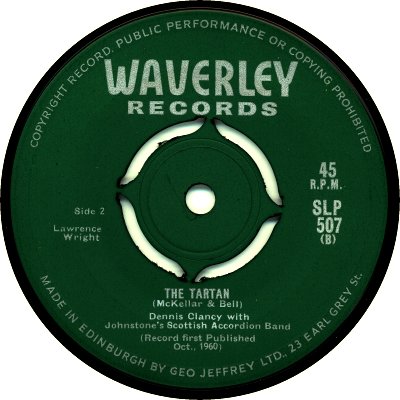

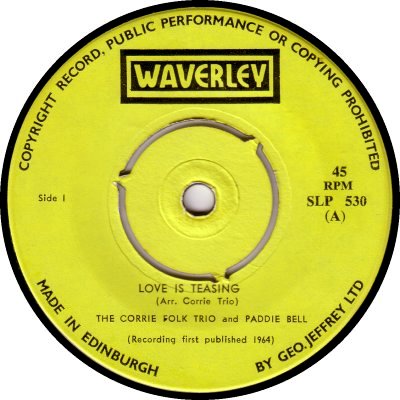

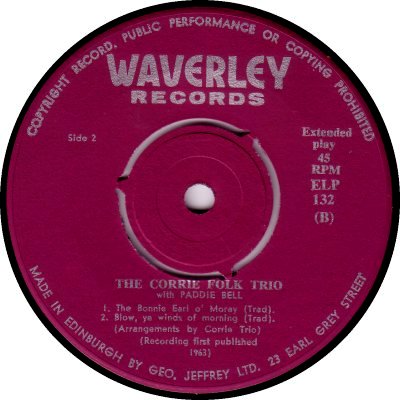
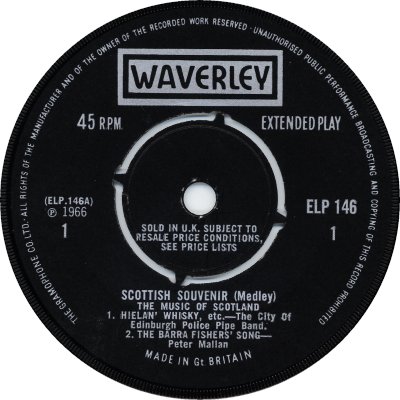
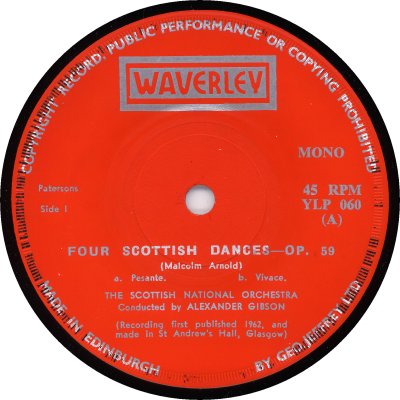

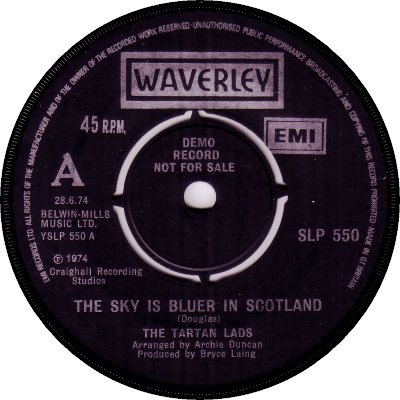

A Scottish label, based in Edinburgh and initially an offshoot of furniture retailers Geo. Jeffrey Ltd. The man behind Waverley was Thomas Bryce Laing, who had risen through the ranks to become managing director at Jeffrey's after the war ('The Scotsman'; 14th September 2005). He persuaded the company to add a record department to their furniture store; then in 1959 at his instigation it added a two-track recording studio, which occupied a back room at the store, and a record label - Waverley - to issue the material that was recorded there. When the building was listed for demolition the record shop and studio were relocated. The studio moved again; by September 1962 it was located at 68 Craighall Road and had become the much-improved Craighall Recording Studios (q.v.). In 1966 Waverley began a close association with EMI. Accounts of the nature of that association differ: 'Music Week' of the 8th of April 1972 said that the label was sold to EMI, and the proceeds put into Craighall Studios; while 'Billboard' of the 9th of April 1966 referred to Waverley as having been 'taken over recently' by EMI. However, in a detailed article about Craighall 'Studio Sound' of October 1983 merely said that Waverley was 'Deeply involved' with EMI, and that from 1966 to 1981 it had been contracted to supply that company with Scottish albums. According to the article, when EMI closed its MOR department in 1981 the relationship with Craighall ended. Significantly it said that Waverley records were being handled by Ross Records of Aberdeen at the time of writing, which seems to indicate that the label was still a going concern after its time with EMI; though no new material appears to have been issued. The article added that Waverley's back catalogue was being used to provide compilation albums for MFP, and that Bryce Laing was still a director of Jeffrey's.
Waverley singles were numbered in an SLP-500 series, and EPs in the ELP-100s; classical EPs had their own YLP-000 numbering, with an initial prefix 'S' for stereo records. The label came in two fairly similar designs and several different colours. Initially singles and EPs shared a green label (1) but at some point in 1963 singles were given a yellow one (2) and EPs a plum-coloured one (5). For both, the logo was enclosed in a box the following year (3). Mono classical music EPs were given their own, red, label, which could be in a dark or bright shade (7); stereo Classical EPs had black labels. When the company linked up with EMI the boxed logo remained unchanged but the colours were altered to black and silver (4, 6). This design saw out the decade, though there was a minor change in the perimeter text: in March 1974 the reference to 'The Gramophone Co' at 8 o'clock was altered to refer to 'EMI Records' (9); a similar change affected most labels in the EMI group at or around that time. The 'Sold in the U.K...' text (6) only appeared on EMI-era records of the 1960s. Re-pressings of popular records can be found with different types of labels. EMI-era demo labels were in one or other of the EMI 'in house' styles: white with a red 'A' (8) until at least March 1968, overprinted issue labels (9) from April 1973 at the latest. During the EMI days Waverley seems to have concentrated on releasing albums rather than singles: there appear to have been no singles issued at all in the years 1969-71, and only eight in the seven years 1972-79, which is the period covered by the discography below. Catalogue numbers suggest that in total at least fifty-six EPs were issued, up to March 1968. Nothing on Waverley ever entered the British Singles Chart, though the 'A' side of SLP-527 will be familiar to millions of people of a certain generation - it was the theme music to the popular BBC TV programme 'Dr. Finlay's Casebook'.



Copyright 2006 Robert Lyons.

